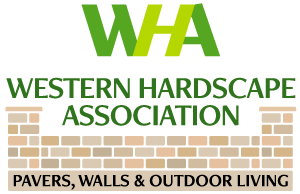Maintenance Tips & Providers
Search our database of contractors and suppliers for additional information
Search our database of contractors and suppliers for additional information
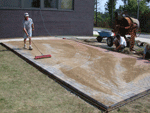 Joint Sand
Joint SandDuring the course of normal use, the sand-filled joints receive dirt from traffic on the pavement. Dirt settles into the top of the joints, helping to hold the sand in place. Installations exposed to driving winds or runoff, however, may lose some joint sand that can be simply replenished with dry sand. If the problem recurs, sealers will help hold the sand in the joints. These are applied over the entire paver surface as a liquid and allowed to soak and cure in the joints. Ask your concrete paver manufacturer or distributor about these products and their application.
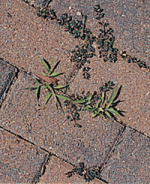 Preventing Weeds and Ants
Preventing Weeds and AntsWeeds can germinate between pavers from windblown seeds lodged in the joints. They don’t grow from the bedding sand, base or soil. Weeds can be removed by hand or with herbicides. Take care in using herbicides so that adjacent vegetated areas are not damaged. Use biodegradable products that won’t damage other vegetation or pollute water supplies when washed from the pavement surface. Besides stabilizing the joint sand, sealers can prevent seeds from germinating, and prevent ants from entering.
Most paver producers add chemicals to the concrete that reduces the likelihood of efflorescence occurring. In most cases, the additives prevent efflorescence. However, completely eliminating the chance of efflorescence isn’t possible because it’s a natural byproduct of hardened concrete.
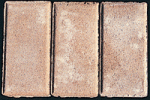 Efflorescence is a white haze that may appear on the surface of pavers sometime after installation. It forms as a result of a natural chemical reaction that occurs when the lime or water soluble calcium oxide produced by the cement contained in the pavers reacts with water. When the water enters the microscopic capillaries in the pavers calcium hydroxide is formed. The calcium hydroxide rises to the surface of the paver, reacts with the carbon dioxide in the air, and forms a white haze of calcium carbonate when the moisture
Efflorescence is a white haze that may appear on the surface of pavers sometime after installation. It forms as a result of a natural chemical reaction that occurs when the lime or water soluble calcium oxide produced by the cement contained in the pavers reacts with water. When the water enters the microscopic capillaries in the pavers calcium hydroxide is formed. The calcium hydroxide rises to the surface of the paver, reacts with the carbon dioxide in the air, and forms a white haze of calcium carbonate when the moisture
on the surface of the pavers evaporates. The appearance of efflorescence will stop when there isn’t any more calcium hydroxide available to move to the surface.
 Since efflorescence brings out salts that are not ordinarily part of the paver, it is not a structural, but, rather, an aesthetic concern. The white haze may give the impression that the color of the pavers is fading but this is not the case. Efflorescence may occur randomly or be concentrated in certain areas. Dark colored pavers show efflorescence more than lighter-colored ones.
Since efflorescence brings out salts that are not ordinarily part of the paver, it is not a structural, but, rather, an aesthetic concern. The white haze may give the impression that the color of the pavers is fading but this is not the case. Efflorescence may occur randomly or be concentrated in certain areas. Dark colored pavers show efflorescence more than lighter-colored ones.
If efflorescence does occur, it can be removed with cleaners specially made for concrete pavers. Careless or improper cleaning can result in damage and discoloration to the concrete paver surfaces. Contact your paver supplier for further information about the chemistry of efflorescence and appropriate commercially available cleaners. ICPI Tech Spec 5—Cleaning, Sealing and Joint Stabilization of Interlocking Concrete Pavement provides additional details.
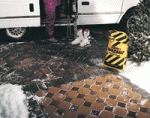 Snow and Ice Removal
Snow and Ice RemovalConcrete pavers offer outstanding freezethaw resistance. They endure de-icing salts much better than most pavement surfaces. Snow and ice are removed with shovels or plows like any other pavement. Electric or liquid snow-melting systems work well under concrete pavers, eliminating plowing while reducing slip hazards. Further information can be found in ICPI Tech Spec 12—Snowmelting Systems for Interlocking Concrete Pavements.
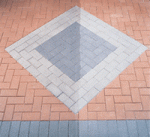 Settlement and Utility Repairs
Settlement and Utility RepairsSettlement is often caused by inadequate soil or base compaction. Other factors can be water in the base or soil, too thick a layer of bedding sand, or washed out bedding and joint sand. Loose or inadequate edge restraints will cause pavers to move apart. Pavers in uneven areas can be removed, the settlement adjusted, and the units reinstated with no wasted paving materials or unsightly patches. If the base or soil has settled and is stable, remove the pavers and bedding sand, place and compact additional base material to the correct level, then add bedding sand. Bedding sand alone shouldn’t be applied to adjust the level of the surface if its thickness exceeds 11/2 in. (40 mm). Concrete pavers can be removed for access to underground utilities, and reinstated after repairs. When utility repairs are complete, fill the trench with base material and compact it. Remove about 18 in. (0.5 m) of pavers on either side of the opening, level the bedding sand and replenish as necessary. Reinstate the pavers, compact, fill the joints with sand and compact the surface again, filling joints as needed. ICPI Tech Spec 6— Reinstatement of Interlocking Concrete Pavements, provides step-by-step guidelines on removal and replacement of concrete pavers.
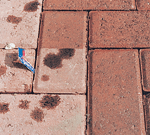 Removing Oil Stains
Removing Oil StainsConcrete pavers on driveways stained by oil leaking from cars aren’t damaged by petroleum products, but the stains can be difficult to remove. Stains should be treated as soon as possible since the longer they remain on the surface, the deeper they penetrate and the harder they are to remove. Wipe excess oil from the surface as soon as possible and apply liquid detergent. Allow it to soak for several minutes. Then wash the pavers with hot water. Several treatments may be necessary for particularly stubborn stains. Cleaners specially made for removing oil stains from concrete pavers are recommended since they yield good results. In some cases, it may be simpler to replace the stained pavers with new ones. Removing oil and many other stains are discussed in ICPI Tech Spec 5—Cleaning and Sealing Interlocking Concrete Pavement. Cleaning and sealing concrete pavers early in their life can make removing stains easier since sealers prevent stains from soaking into the surface. However, the sealers may need to be reapplied from time to time due to wear and weather. Concrete pavers should be cleaned prior to applying a sealer to obtain the best performance and appearance. Your paver source can provide information on cleaners and sealers specifically made for concrete pavers.
The Western Hardscape Association (WHA) offers courses to help professionals become certified, along with numerous networking events and more throughout the year.
Western Hardscape Association connects you with skilled contractors specializing in creating beautiful, high-quality hardscape projects. Our professionals have the expertise, equipment, and materials to turn your vision into reality, ensuring a safe and exceptional outcome for your home.
